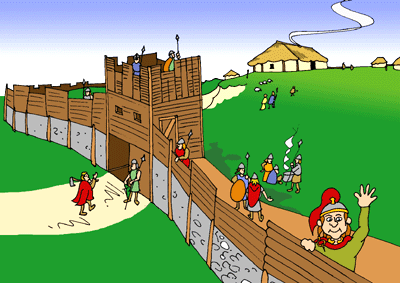|

|
|

The Castles of the
Dark Ages
 Hillforts are what they sound
like: forts built on hills. Many can be seen around the countryside
today. Hillforts are what they sound
like: forts built on hills. Many can be seen around the countryside
today.- They cover large areas of land
and are surrounded by big earth banks and ditches. The banks
originally had strong wooden walls on top, but they have rotted away. Click
here to see a picture taken from an aeroplane.
- The hillforts were built by the
chiefs of British tribes before the Romans came to Britain. Some of
them were built over 1,000 years before the Dark Ages.
- The Romans moved all the people
who lived in hillforts into new towns. No-one lived there anymore;
but, after the Romans left, the towns
became unpopular.
- Some British kings and
lords
returned to live in the hillforts. They rebuilt the fortifications
(walls, ditches and gateways) to keep out Saxon attacks.
- Inside each fort, they might
build a great hall to live in, smaller
houses for servants, kitchens, workshops and lots of granaries (small houses for storing
grain from which to make bread).
- Archaeologists have dug up many
good examples: South Cadbury & Glastonbury Tor in Somerset,
Tintagel in Cornwall, Dinas Emrys, Degannwy & Dinorben in North
Wales and Dinas Powys in South Wales
- Ordinary people, who did jobs for
the lord, might also live in small houses nearby, similar to those on British
farms.
- Some lords did not have any
nearby hillforts they could live in. So they built new but smaller
versions. They surrounded their great hall by small earth banks which
formed little forts. A good example is Castle Dore in Cornwall.
- In the 9th century, the Saxons
also refortified some Hillforts. They turned them into Burghs.
|

